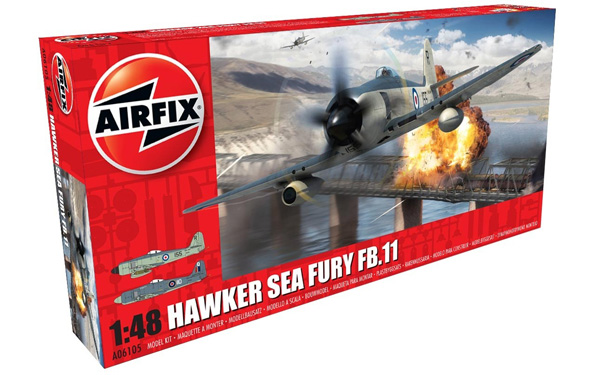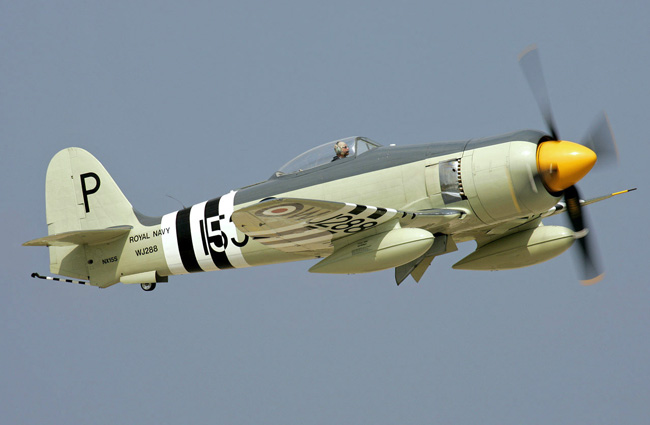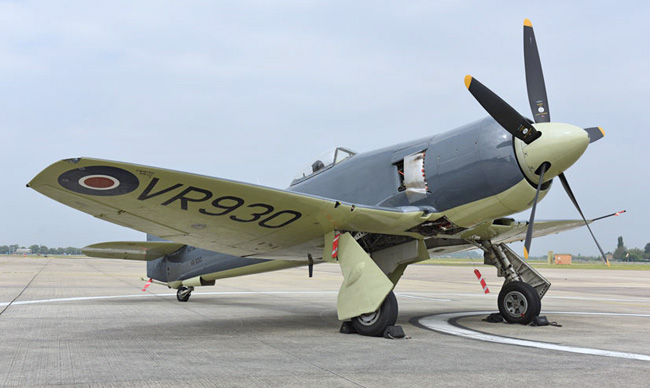
Reviewed by Mick Stephen
When Airfix announced in late 2016 a new tool 1:48 scale Hawker Sea Fury for sometime in 2018, I vowed then to be quick off the mark and get my sticky paws on one. True to their word January 2018 saw the release to market and my trusty plastic cash was brought to life. (don’t tell the missus)
To date the only examples you could find of the Sea Fury in this scale were by Trumpeter, Hobbycraft, AMG, Aeromaster and RedRoo. Could Airfix follow their recent spate of sublime efforts and produce the defining kit? Well let’s find out…………..first a bit of background.

Last of the piston engined fighters
One of the most capable piston engined fighter aircraft ever produced and the last to enter service with Britain’s Fleet Air Arm, the Hawker Sea Fury represented the pinnacle of piston engined fighter design. Introduced after the end of the Second World War, the Sea Fury would see combat against some of the early jet fighters during the Korean War, where it would perform extremely well.
The development of the Hawker Sea Fury can be traced back to the inadvertent landing of a Focke Wulf FW 190 at an RAF airfield in South Wales back in 1942. The opportunity to evaluate this latest Luftwaffe fighter resulted in requirements being issued for a new British design, which must have the performance to better the Focke Wulf in every phase of flight and ensure the RAF could secure air superiority. The protracted development of the new fighter resulted in a number of specification alterations and the RAF eventually withdrawing their interest, leaving the new aircraft to be produced as a high performance naval fighter.
The first deck landing trials commenced in the winter of 1946 and the navy had their ultimate piston engined fighter. Despite the advent of the jet engine, the Sea Fury would remain as the Fleet Air Arms principle single seat fighter until 1953, when it would be replaced by the jet powered Hawker Sea Hawk. The aircraft also saw service with a number of overseas air arms, in a variety of operational roles, including strike fighter, trainer and high speed target towing. As one of the most capable piston engined fighters ever produced, the Sea Fury would also become a popular aircraft in the world of air racing, where the brute power and sheer speed of this magnificent aircraft saw it victorious in countless competitions.
With the end of the Second World War in Europe in sight, the RAF began cancelling many aircraft orders. Thus, the RAF’s order for the Fury was cancelled before any production examples were built because the RAF already had excessive numbers of late Mark Spitfires and Tempests and viewed the Fury as an additional overlap with these aircraft. Although the RAF had pulled out of the programme, development of the type continued as the Sea Fury. Many of the Navy’s carrier fighters were either lend-lease Chance-Vought Corsair aircraft and thus to be returned, or in the case of the Supermarine Seafire had considerable drawbacks as naval aircraft such as narrow undercarriages. The Admiralty opted to procure the Sea Fury as the successor to these aircraft instead of purchasing the lend-lease aircraft outright.
A naval version
While the RAF contract had been cancelled, the Fury prototypes were completed and used for work in developing the Sea Fury as well as for the export market.
The first Sea Fury prototype, SR661, first flew at Langley, Berkshire, on 21 February 1945, powered by a Centaurus XII engine. This prototype had a “stinger”-type tailhook for arrested carrier landings, but lacked folding wings for storage. SR666, the second prototype, which flew on 12 October 1945, was powered by a Bristol Centaurus XV that turned a new, five-bladed Rotol propeller and did feature folding wings. Specification N.7/43 was modified to N.22/43, now representing an order for 200 aircraft. Of these, 100 were to be built at Boulton-Paul’s Wolverhampton factory.
In 1945, the original order to specification N.22/43 was reduced to 100 aircraft; as a result, the manufacturing agreement with Boulton-Paul was ended and all work on the Sea Fury transferred to Hawker Aircraft’s facilities at Kingston. This included the construction of what was intended to be a Boulton-Paul built Sea Fury prototype, VB857, which was transported to Kingston in January 1945; this aircraft, built to the same standard as SR666, first flew on 31 January 1946. Immediately upon completion of the first three airframes, the flight testing programme began at Kingston. It was soon discovered that the early Centaurus engine suffered frequent crankshaft failure due to a poorly designed lubrication system, which led to incidents of the engine seizing while in mid-flight. The problem was resolved when Bristol’s improved Centaurus 18 engine replaced the earlier engine variant.
The Sea Fury is a fully navalised aircraft, capable of operating from the aircraft carriers of the Royal Navy. It was heavily based on preceding Hawker fighter aircraft, particularly the Tempest; features such as the semi-elliptical wing and fuselage were derived directly from the Tempest but featured significant refinements, including significant strengthening to withstand the stresses of carrier landings. While the Sea Fury was lighter and smaller than the Tempest, advanced aspects of the Sea Fury’s design such as its Centaurus engine meant it was also considerably more powerful and faster; the Sea Fury has the distinction of being the final and fastest of Hawker’s piston-engined aircraft, as well as being one of the fastest production piston engined fighters ever produced.
The performance of the Sea Fury was striking; in comparison with the 15 years older Hawker Fury biplane the Sea Fury was nearly twice as fast and had double the rate of climb despite far heavier equipment and greater range. The Sea Fury Mk X was capable of attaining a maximum speed of 460 mph and climb to a height of 20,000 feet in under five minutes. The Sea Fury was reportedly a highly aerobatic aircraft with favourable flying behaviour at all heights and speeds, although intentional spinning of the aircraft was banned during the type’s military service. During flight displays, the Sea Fury could demonstrate its ability to perform rapid rolls at a rate of 100 degrees per second, attributed to the spring tab equipped ailerons. For extra thrust on takeoff Jet Assisted Take Off (JATO) could be used.
The Sea Fury was powered by the newly developed Bristol Centaurus piston engine, which drove a five-bladed propeller. Many of the engine’s subsystems, such as the fully automated cooling system, cockpit gauges, and fuel booster pump were electrical, powered by an engine-driven generator supplemented by two independent batteries. The hydraulic system, necessary to operate the retractable undercarriage, tail hook, and flaps, was pressurised to 1,800 psi by an engine-driven pump. If this failed, a hand pump in the cockpit could also power these systems. A pneumatic pump was driven by the engine for the brakes. Internal fuel was stored in a total of five self-sealing fuel tanks, two within the fuselage directly in front of the cockpit and three housed within the wings.
Various avionics systems were used on Sea Furies; in this respect it was unusually well equipped for an aircraft of the era. Many aircraft would be equipped with on-board radar, often the ARI 5307 ZBX, which could be directly integrated with a four-channel VHF radio system. Several of the navigational aids, such as the altimeter and G2F compass, were also advanced; many of these subsystems would appear on subsequent jet aircraft with little or no alteration. Other aspects of the Sea Fury, such as the majority of the flight controls, were conventional. Some controls were electrically powered, such as the weapons controls, on-board cameras, and the gyro gunsight.
Although the Sea Fury had been originally developed as a pure air superiority fighter, the Royal Navy viewed the solid construction and payload capabilities of the airframe as positive attributes for ground attack as well; accordingly, Hawker tested and cleared the type to use a wide range of armaments and support equipment. Each aircraft had four wing-mounted 20 mm Hispano V cannon, with up to 16 rocket projectiles, or a combination of 500 lb or 1000 lb bombs being carried too. Other loads included 1000 lb incendiary bombs, mines, type 2 smoke floats or 90 gallon fuel tanks. The Sea Fury could also be fitted with both vertical and oblique cameras with a dedicated control box in the cockpit, for photo reconnaissance missions. Other ancillary equipment included chaff to evade hostile missile attack and flares.
The Sea Fury FB 11 single-seat fighter-bomber was produced for the Royal Navy, Royal Australian Navy and Royal Canadian Navy, 615 were built, including 31 for the RAN and 53 for the RCN.
The Korean War
Following the outbreak of the Korean War on 25 June 1950, Sea Furies were dispatched to the region as a part of the British Commonwealth Forces Korea, Britain’s contribution to the United Nations multinational task force to assist South Korea following an invasion by North Korea. Sea Furies were flown throughout the conflict, primarily as ground-attack aircraft, from the Royal Navy light fleet carriers HMS Glory, HMS Theseus, HMS Ocean, and the Australian carrier HMAS Sydney. After a Fleet Air Arm Seafire was shot down by a United States Air Force Boeing B-29 Superfortress on 28 July 1950, which today we would refer to as a “Blue on Blue”, all Commonwealth aircraft were painted with black and white Invasion stripes.
The first Sea Furies arrived in theatre with 807 Naval Air Squadron embarked on HMS Theseus, which relieved HMS Triumph in October 1950. Operations on Theseus were intense, and the Sea Furies of 807 Squadron flew a total of 264 combat sorties in October. During a brief rest period at the Japanese port of Iwakuni the catapult was found to be excessively worn, necessitating the launch of Sea Furies with RATOG assistance until it was repaired. In December 1950, Sea Furies conducted several strikes on bridges, airfields, and railways to disrupt North Korean logistics, flying a further 332 sorties without incurring any losses. At this early point in the war little aerial resistance was encountered and the biggest threats were ground-based anti-aircraft fire or technical problems.
In addition to their ground attack role, Sea Furies also performed air patrols. In this role a total of 3,900 interceptions were carried out, although none of the intercepted aircraft turned out to be hostile. During the winter period, the Sea Furies were often called upon as spotter aircraft for UN artillery around Inchon, Wonsan, and Songiin. In April 1951, 804 Naval Air Squadron operating off HMS Glory, replaced 807 Squadron, which in turn was replaced by HMAS Sydney in September 1951 with 805 and 808 Squadron RAN. The Australian carrier air group flew 2,366 combat sorties. In January 1952, HMS Glory with 804 NAS returned to relieve Sydney following a refit in Australia. For the rest of the war Glory and Ocean relieved each other on duty.
In 1952, the first Chinese MiG-15 jet fighters appeared. On 8 August 1952, Lieutenant Peter “Hoagy” Carmichael, of 802 Squadron, flying Sea Fury WJ232 from HMS Ocean, shot a MiG-15 down, making him one of only a few pilots of a propeller driven aircraft to shoot down a jet. The engagement occurred when a formation of Sea Furies and Fireflies was engaged by eight MiG-15s, during which one Firefly was badly damaged while the Sea Furies escaped unharmed. Some sources claim that this is the only successful engagement by a British pilot in a British aircraft during the Korean War, although a few sources claim a second MiG was downed or damaged in the same action.
Australia was one of three Commonwealth nations to operate the Sea Fury, with the others being Canada and Pakistan. The type was operated by two frontline squadrons of the Royal Australian Navy, 805 Squadron and 808 Squadron; a third squadron that flew the Sea Fury, 850 Squadron, was also briefly active. Two Australian aircraft carriers, HMAS Sydney and HMAS Vengeance, employed Sea Furies in their air wings. The Sea Fury was used by Australia during the Korean War, flying from carriers based along the Korean coast in support of friendly ground forces. The Sea Fury would be operated by Australian forces between 1948 and 1962.
Source: Wikipedia – Hawker Sea Fury
A few flying examples remain, one of the most recognisable is operated by the Royal Navy Historic Flight, on which the Airfix release is based.
